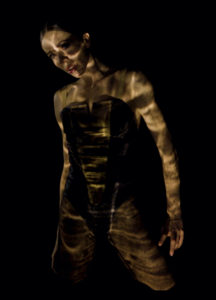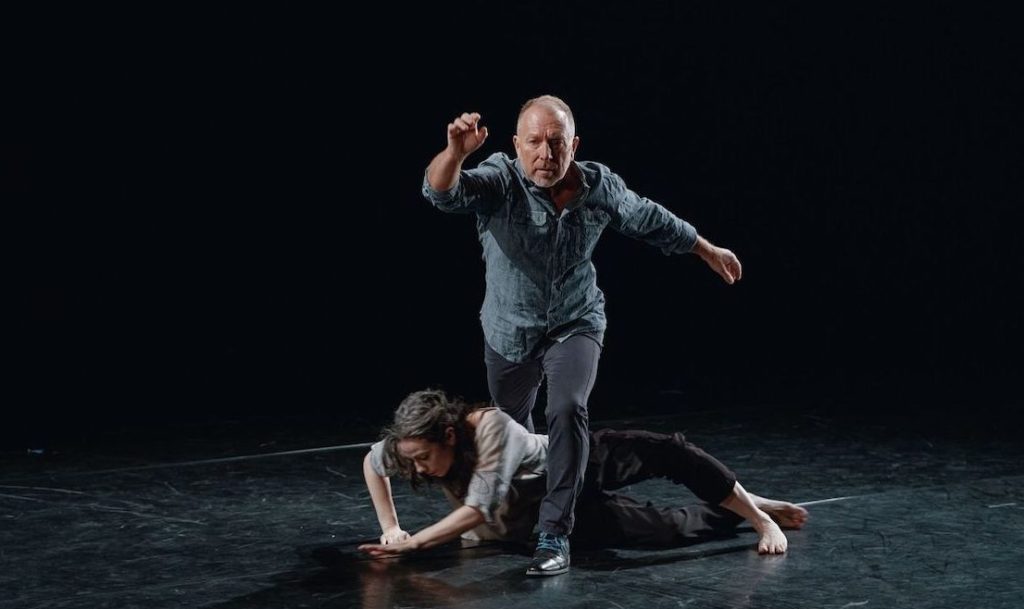Montreal: Beginning with Lecavalier and Lock - Vancouver Ballet Society
- Home
- City Reports 2020 - 2023
- Montreal: Beginning with Lecavalier and Lock

By Victor Swoboda
With COVID masks and vaccination documents at the ready, spectators filed into downtown Montreal theatres for a busy fall dance season. In September at Usine C, Louise Lecavalier presented Stations, first seen last year in Europe. Like her earlier choreographies, So Blue and Battleground, Stations was a kinetic marvel. With extraordinary coordination, Lecavalier executed an infinite variety of quicksilver gestures. Eternally spry, her body utterly relaxed, she was as ever the virtuoso, hopping on one leg while extending the other in a slow, controlled développé. Lecavalier explored every part of a large space bare except for slender vertical columns at each corner that glowed occasionally to signal a change of mood. Observing such a concentrated, intense performer infusing each move and gesture with her personality, there was no need to search for the work’s “meaning” or “message.” The medium — Lecavalier — was the message.

Lecavalier was, of course, the long-time muse of Édouard Lock, who left Montreal in 2015 after disbanding La La La Human Steps. To open October’s triple bill in Salle Wilfrid-Pelletier at Place des Arts, Les Grands Ballets Canadiens presented Lock’s profound new solo, Echo, which he conceived as a short film. Appearing on an immense screen, enveloped in Lock’s beloved dark lighting, principal dancer Rachele Buriassi appeared in black tights and toe shoes. She superbly interpreted Lock’s characteristic rapid pirouettes and darting arms with a delicacy unlike the sawing thrusts familiar from his previous work. Her arching, stretching body also expressed a languor unusual in Lock’s work. Often her shape and gaze were conspicuously reflected in the mirror-like floor. The film over, Buriassi suddenly appeared onstage to continue the solo in a live echo of the film. The contrast between her towering filmed image and the diminutive figure onstage spoke of fragility and mortality. Contemplating her reflection in a tiny circle of light on the floor, she might have been Narcissus. She might equally have been a shivering consciousness gazing at a light in a blank universe. Echo — stark yet classically lovely — reached a new depth in Lock’s artistry. Afterwards, onstage, Lock was visibly touched by the audience’s ovation. A pity that Echo will remain henceforth only on film.
Les Grands’ second piece, Gaby Baars’ new half-hour work, Rule 26½, mixed tones wildly. Cabaret-style lifts, golden leotards, superhero music, West Side Story rumbles, academic ballet positions — the mishmash was entertaining at best, kitschy at worst. Happily, the work gave the full company ample chance to shine both individually and as a well-coordinated ensemble. So, too, did the closing piece with live orchestra, Mauro Bigonzetti’s Four Seasons, which the company premiered in 2007. Bigonzetti’s clever use of rhythm, visual pranks, and witty exchanges between dancers created a rich visual counterpoint to Vivaldi’s familiar music.

As part of the 19th Festival Quartiers Danses’ 12 days of indoor and outdoor performances, Věra Kvarčáková and Jérémy Galdéano, both formerly with Les Grands Ballets Canadiens, presented FOMO for seven dancers at the Cinquième Salle of Place des Arts. FOMO (Fear of Missing Out) illustrated the pressure that people feel from social media. Interspaced within high-energy, fast-paced ensemble formations, soloists gesticulated under cones of light while their peers either encouraged or accosted them. Drawing heavily on the vocabulary of Mats Ek, Mauro Bigonzetti and Ohad Naharin, the two choreographers infused the vibrant choreography with their own confident personalities. The balance, timing, strength, and flexibility of classically trained dancers were constantly on view. Kvarčáková and Galdéano are quickly forging a notable choreographic career.
Also at the Cinquième Salle, Margie Gillis presented several new pieces entitled Histoires d’isolement created during the COVID lockdown. Susan Paulson and Marc Daigle showed a delicate physicality in a touching duet of minimalist gestures. Daigle later performed a solo of despair with butoh-like pacing. Such minimalist restraint suggested a powerful innovation in Gillis’ 40-year-plus career. Other solos, however, embraced her old familiar vocabulary — posing, pretty gestures, wafting arms, edginess. In one solo, Ruth Naomi Levin moved and looked startlingly like the young Gillis with the same early-period twitching and skipping mannerisms.

Maria Kefirova’s latest solo, backs boxes towels, opened the season at MAI (Montréal Arts Interculturels). Kefirova’s works are often purely conceptual, but during one long segment, she performed an astonishing number of rapid hand-and-arm combinations. Showing a constant, calm self-control, she compelled attention even during banal actions like blowing through a straw or building and carrying cardboard boxes. It was an invitation to live and enjoy the present moment, as in Zen. Kefirova was so detached that when she quietly left the theatre space, the audience sat puzzled for a long moment before realizing she was outside waiting to show her small drawings displayed in the adjoining room.
Ebnflōh’s director, Alexandra Landé, aka Spicey, came out of Montreal’s urban dance scene. In La Probabilité du néant, presented by Danse Danse, dancers in street clothes executed cool hip-hop moves within a context of formal movement patterns and formations. These were arranged across an expansive rehearsal space at Place des Art’s Théâtre Maisonneuve, which was turned into a theatre with bleachers. Some of the ensemble choreography drew on contemporary-dance patterns used so often that they have become cliché — dancers rushing upstage and down in turn, dancers staring at the audience, dancers in a group confronting an individual. Overall, this was a slick meeting of contemporary dance and urban cool.
Upcoming, Ballets Jazz Montréal (the latest official name of Les Ballets Jazz de Montréal) will celebrate its 50th anniversary with Vanishing Mélodies, set to 15 songs by Patrick Watson, as part of the Danse Danse fall series, from November 2-6. The choreography is a collaboration between Brazilian Juliano Nunes, who has staged dances in Europe; Anne Plamondon, formerly co-director of Montreal’s RUBBERBAND; and Éric Jean, the former artistic director of Montreal’s Théâtre de Quat’Sous who collaborated on Ballets Jazz Montréal’s Leonard Cohen tribute.

